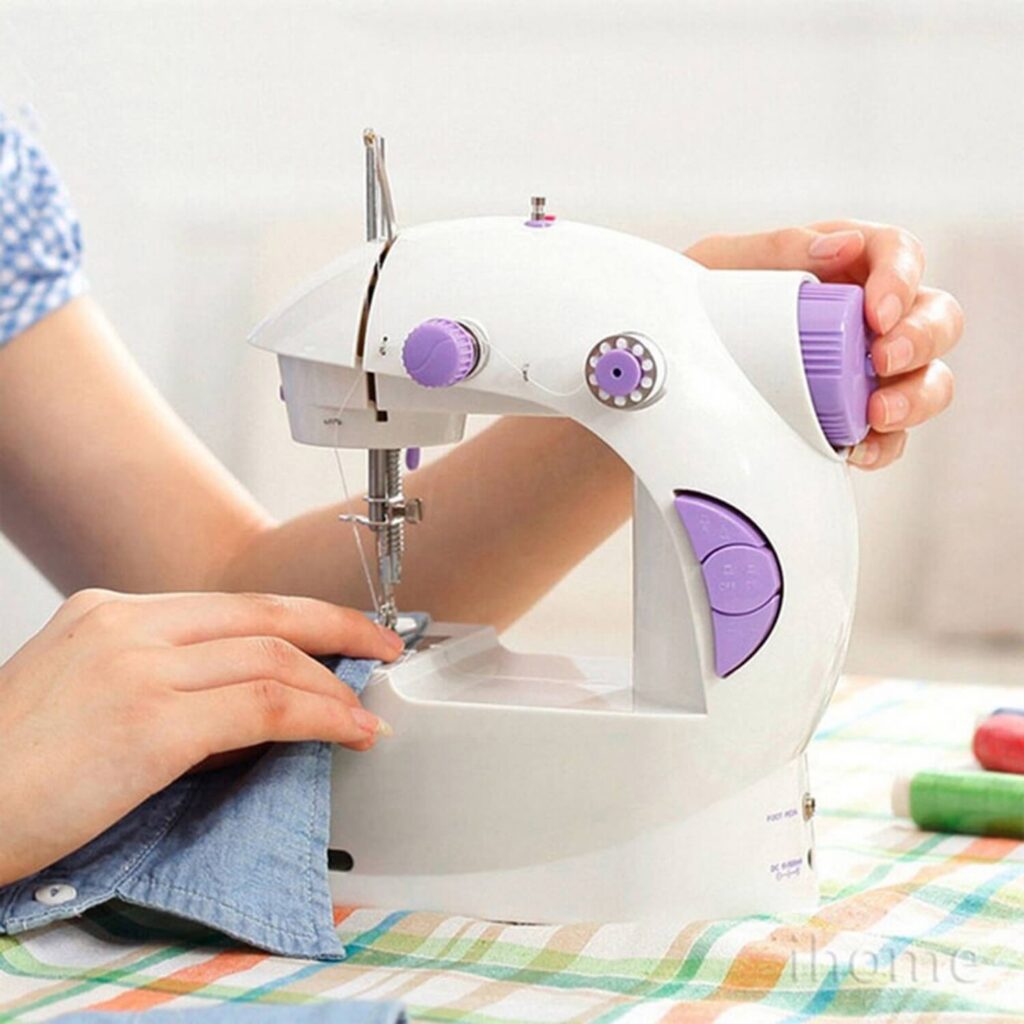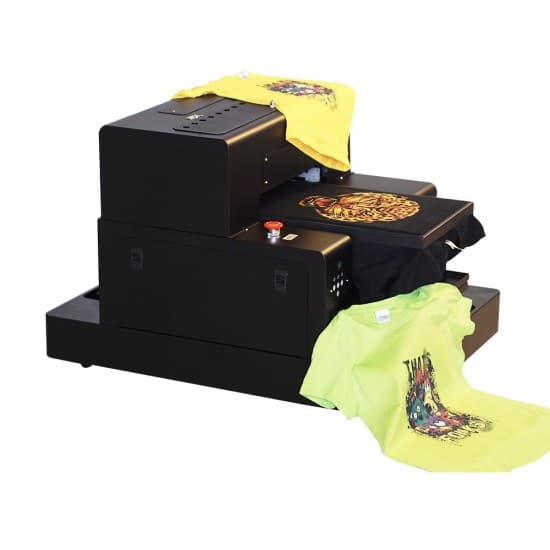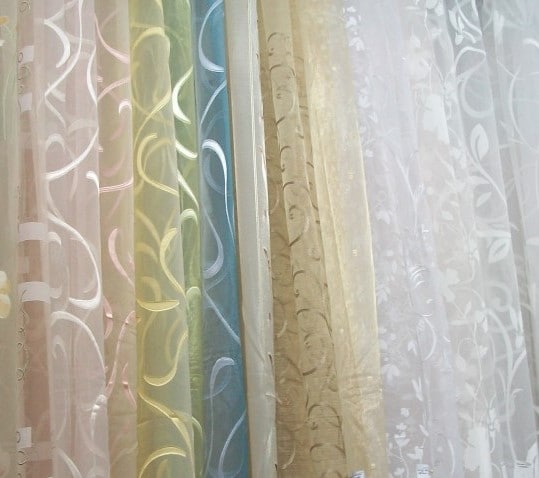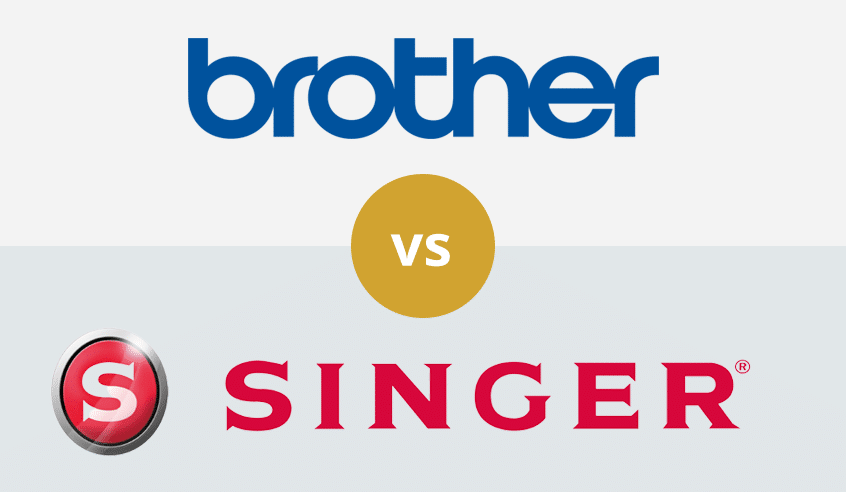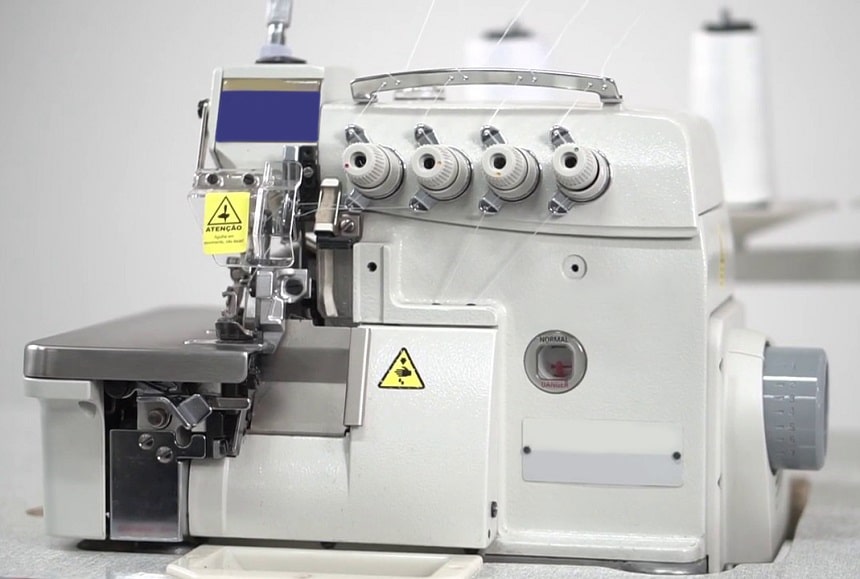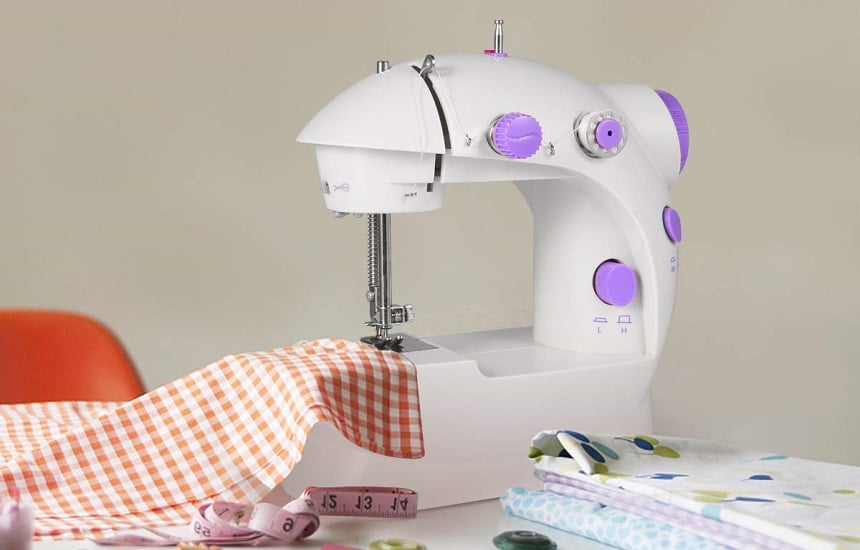

When it comes to embroidery software, a lot of people are looking for something unique, and want their designs brought to life in a specific way. Using the best embroidery software is your best chance to make this happen, but what’s best for one person might not be best for someone else, this is why we have created this full, extensive guide to embroidery software, in this we discuss the very best software available, but also different options based on what specific features and functions you need.
When creating our embroidery software reviews, we’ve looked at a number of different factors including compatibility with both machines and with computer types, the type of projects and files it can read and export, and any inbuilt designs that come with the software in the first place. Whether you are a hobbyist wanting to experiment or you are running an embroidery factory professionally we have software on our list that can help you to make the right decisions and get the end result you are hoping for. The variation between the products at the top of the market and those at the bottom is stark, so you will want to make sure you don’t get stung by making the wrong decision on your embroidery gear, and this includes the software!
Embrilliance Essentials is a great piece of software that gives you full control and autonomy over all of the editing of your designs, and there are loads of designs inbuilt, too. It’s fairly easy to get to grips with and has a huge number of file formats that it understands and works with.
It lets you do things like resizing automatically, and it will recalculate the stitches for you based on your new design size. It also lets you overlap different designs. Plus, if you can use basic software like Microsoft Paint then it isn’t too much of a step up. You really can find this easy to operate and all of the options are laid out in a simple way.
The software is mac and PC compatible. You can connect to virtually any embroidering machine, too, so you don’t have to spend ages trying to work out whether or not this is a viable option for your computer or your machine.
Loads of text options are included and you can use monogram, circle and even spiral designs which many of the other softwares can’t compute in a way that is easy for embroidery machines. You can colorize the designs and have full control over designs that use multiple colors. Plus, if you want to add some other, more interesting elements to the design you can use their inbuilt library. There are loads of different images and shapes you can make use of. There are 12 fonts included and 10 different frames, too. You really don’t need to worry about running out of design ideas.
Embrilliance Essentials is one of a few different models from the same brand, which all have their own place on the market. This is a good option for beginners and pros alike. Easy to use but with plenty of options still in place for everyone to utilize.
Taking the second position on our list is the M & R Technologies pc Pro Cross Stitch Software, which we named the best value. It allows you to create a unique design with ease, saving the time and energy you might spend looking in craft stores and magazines instead. With the software, you can import photos, graphics, logos, and more into the workspace for flexibility and easy use. It also gives your embroidery a sense of professionalism.
The M & R Technologies pc Pro Cross Stitch Software is best suited for anyone working with a budget. If you want to avoid spending a lot of money on your software but still want high quality, this is ideal. Compatible with Windows XP and above, the software makes it easy to create complicated or simple cross stitch patterns. Its functionality is easy, yet the entire software is sophisticated, giving you good value for your money.
You will probably be familiar with the Brother brand if you are getting into embroidery machines or you want to learn about monogramming. Brother manufacture a lot of sewing machines and, of course, embroidery machines. If you have a model that was made by Brother then it might make sense to go with their software, too.
As you would expect, this is easy to link up to all Brother hardware, this means if you are running one of their machines then you can easily start to control it via their software, too.
There are lots of tools that you would expect from this sort of software including reshape resize, align and flip tools. It feels like the Photoshop of embroidery machines.
This does actually come with some embroidery machines as standard. You can get to grips with the software and start to use it in an effective way in just a few hours, or sometimes even quicker if you are already tech savvy.
The install is easy enough and you can put this on machines running the newer versions of Windows, 7 and up. It is some of the best monogramming software out there too. There are five different monogramming fonts you can use, so you don’t need to worry about running out of design options. In terms of full lettering fonts for embroidery, there are 25 of them, which is plenty of choice.
Sadly, there is no option to use the software on Mac, so you will need a PC if you are going to use this software. There is a bonus, though. If you don’t have a Brother machine, that doesn’t rule you out of using their software. It is compatible with other brands of embroidery machine, too. Whatever you are running, you can use this to create interesting designs.
It’s very hard to make a list of best embroidery software reviews without this brand coming up a lot. The Embrilliance StitchArtist Level 1 is a powerful piece of software and it can be used just as easily on Mac and on PC. In fact, this has been named as our best embroidery editor software for Mac due to the fact that it runs so well on their OS.
You can either use existing artwork and upload this within the software to create designs or “digitize” it or you can use their easy platform to create designs from scratch, and within this there are just so many options. Fill and emboss patterns are not something that some of the other software allows for. With the Embrilliance StitchArtist Level 1 you can make much more complicated designs.
You would think that this comes with a lot more complexity in terms of actually using the software, but this is not really the case at all. The software uses just one mode for everything, where you can draw shapes, set the properties of imported graphics and design objects and set the stitches. Simple controls for resizing and rotating are also possible within this mode, and for something that creates such pro results, it actually feels pretty simple to get a grasp of.
The user guide that is included is also very good, and it guides you through all you could need to learn to get a thorough understanding of this software. It really allows you to set your creativity free in ways some of the more limited options don’t, especially if you are running a Mac.
Level 1 is for hobbyists mainly, and it doesn’t have the most professional fonts and designs we’ve seen, but it is still a pretty great option for those getting started on an embroidery journey or those who are using simple machines.
When it comes to sewing and embroidery then Singer is another absolute powerhouse brand, and as such, they have their own software. This allows you to get the most out of some of the Singer options of embroidery and sewing machine such as the Futura CE-150 and CE-250 designs.
Though this is wonderful if you have one of these machines, or are still undecided and feel that you might buy one of these machines, it can be a bit of a disappointment if you are not running Singer. In this case, we recommend you go for one of the other options.
Though this doesn’t have as many fonts as many would like (only five bonus fonts are included) it does have some powerful editing tools for creating amazingly complex and interesting designs, and the fact it links so well with the machines is a huge bonus.
It features fill settings to allow you to make all of the letters look unique and interesting, and can tune existing images to turn them into cool embroidery designs. You can also create specific lace textures if you wish.
The software, disappointingly, only runs on PC. This might not be a problem but if you are a Mac user and you want to use the bespoke Singer software then you might find a stumbling block!
In terms of the system you are running, it can also take up a fair bit of space on your hard drive. In general, this software is fantastic and while it could do with some more fonts it is probably the best machine embroidery software if you are running one of the following machines: Singer Futura CE-150, CE-120, CE-350, SES1000, and SES2000.
We’ve named the Floriani Total Control U Embroidery Software the best for advanced users. It is for professional functions and can handle monogramming as well as all types of embroidery. When we say this is good for advanced users, keep in mind the fact that if you don’t feel that you fell into that category, you might have a steep learning curve if you want to get to the ability level where you can use this. As you can see from their example designs, though, the Floriani software is powerful.
Where to start with all of the different functionality? It can do almost anything. A full list of the functions and features can be found on the product listing. Examples include an amazing inside-out text function which allows you to embroider onto caps or even the back of jackets. Loads of artwork and digitizing tools for taking images and existing designs and turning them into something you can embroider, and a level of control that you simply won’t find with cheaper software. If you have ever used a professional version of Photoshop for editing photos, that is something we would compare Total Control U to.
There is a huge design library, too. Even if you don’t feel like you have totally mastered the software (it is incredibly difficult) then you might be able to put together some designs using this. There is a drag and drop functionality.
Loads of embossing and fill options are included as well as ZigZag, Wave, Twirl, Pinch, and Spherize Distortion that you can add to objects. You can create virtually unlimited designs with this software that we would say is industry-standard.
For that reason, it is probably best avoided by some of the hobbyists who are just getting started. if you aren’t that tech-savvy then this software might be tough, and even if you are expect to spend many hours watching YouTube videos to try and work out the exact next steps to take when making your design. This also needs a powerful PC to get the most out of it.
Okay, so the previous option was very professional, but for the very best professional embroidery software for commercial use, we have to recommend the DIME Perfect Embroidery Professional.
One of the very best things about this software, besides the fact that it is professional grade and suitable for use in all sorts of environments where embroidery is required (factories, for instance), is the fact that it has over 140 different fonts to use. On some of the other options on the list, we’ve seen 10-20 fonts or even less. This is fine for a hobbyist but for a professional it is nice to have all of these available.
As you can see, there are a huge amount of file formats that can work with the DIME software and it is compatible with pretty much every embroidery machine you can imagine.
The amazing digitizing features let you create custom Appliqué designs with ease, and the “Auto Digitizing Wizard” even helps to make your life a little easier. It is not simple and easy software to get started with, but it certainly does have a very good set of features that allow you to do pretty much anything you can dream of with the design. Embroidery for the 21st century.
The shear number of editing functions and the control you can have on design should show you what you are dealing with when it comes to this pricey but pro software. You can edit density, stitch lengths, change the stitching angles, change an object’s shape, and even create emboss lines
There are a number of different alignment tools and stitch points that let you make endless alterations and perfections. On top of this, there is unlimited undo! If you make an error and you want to go back to an earlier point in your design, you can.
The whole sequence of designing is fantastic if you can get to grips with the software.
PE Design Plus 2 Personal Embroidery Design Software System is the best embroidery software for Brother machines specifically. It has a USB dongle which connects to your Brother embroidery machine, giving you the security of knowledge that you are going to be able to connect at all times and digitize your photos with ease, as well as come up with monogramming and embroidery designs.
There are 35 full fonts as well as five other small fonts which are good for some forms of monogramming, though this is one of the best embroidery software for monogramming it is more expensive than some specific monogram software.
It’s great for working with appliques as well as having loads of design elements and functionality. There is a full Applique Wizard, which means you can take any embroidery design and turn it into a simple to use applique. It is recommended that you use this with the
ScanNCut Home & Hobby Cutting Machine.
Once again, this software is only suitable for use on a Windows computer, and supports more modern releases of Windows, too. This rules out Mac OS users.
There are 287 built-in embroidery designs to get you started, this library is a small fraction of what you can do when you start uploading your own, but it is a good way to get to grips with the Brother software and quickly start making designs that look good.
It’s quite specific what hardware you need to run this, so it won’t be suitable for every single person out there who wants to get started with embroidery software. That said, it is great for Brother users as the file types it use match up, and it is somewhere in the mid-range in terms of price, when compared to other professional embroidery software choices.
Looking for something that has a real luxury in features? This could be the answer for you. DRAWings PRO XI specializes in a lot of things. This means that there is a possibility of creating complex embroidery with various tools and features.
It lets you use 200 vector files and 3,000 built-in embroidery designs so if you want to very quickly throw something together that looks good, this could be one of the best options. The software works with an incredible number of different file formats and can be fantastic for those who are looking to get started quickly.
Fortunately, in terms of the tech specs and compatibility, this can be used with Windows 7, 8, 10, and MacOS variable versions, so you won’t really have to worry in that regard. You also need a DVDrom drive and 1,5GB on your hard drive, and you can’t install this in any other way.
There is quite a bit that you can do with the software. However, it’s not really easy to use, as it is full of various features and tools, so you might have to learn the navigation first. This software is capable of graphics designing, textile and screen printing, embroidery, computerized quilting, crafting with cuts and stencils, fabric painting.
If you want to create huge, exciting designs that wow people then this might have everything you need as a piece of software, the same applies if you are running brand new computers, but it is not the best option if you want an easy to use simple software.
If you are considering buying software such as the EmbroideryWorks Everyday Software then you are probably looking for the best digitizing software for commercial embroidery. Rather than being a hobbyist, people who buy this software are usually pretty serious about what they want their designs to be able to do. We’ve named it as the best for PC, as if you are running a computer that is powerful then you can usually find that this will allow you to do exactly what you want (just as long as you can effectively use all of those controls.
It allows for easy resizing of existing scans and designs, between 50% and 250% of the original sizing. The stitches even change automatically to suit Embroideryworks or lettering.
You can control more advanced aspects of the design including density, which some of the cheaper, beginner embroidery software simply doesn’t support.
You can also take other designs and merge them together for your own unique piece of embroidery or monogramming. As well as using a huge variety of downloadable resources you can make use of 12 fonts, 12 frames, 100 shapes, and way more tools than you will probably ever need to use within this software. Other powerful tools include the option to use circular or spiralled text, and 12 different lettering styles. You can also use mirror and scatter effects to fill out larger designs and create interesting looks and patterns. There’s a huge Applique library which works well with the quilting addon that is also available from the brand, AccuQuilt GO! Fabric Cutter.
You need a decent PC and machine to run this software, it definitely has more of a pro feel when compared to some of the models that are significantly cheaper, but the EmbroideryWorks Everyday Software can support people who use embroidery to make a living.
Are you looking for the best embroidery design software but also you don’t want to spend the earth getting your hands on it? The Amazing Designs LETTER IT! could be for you. In spite of being more affordable than a lot of the other choices on the market, there is still a lot to like about it, as long as you are a PC user rather than Mac as this doesn’t have a Mac compatible version.
There are an incredible 35 different fonts included and this can be good for both monogramming and for full embroidery. These can be arranged in a number of single or multi-line text patterns too. It has clear instructions and while the use isn’t as straightforward as some of the competing models it isn’t too hard to get going.
You can use path, circle and vertical text and a variety of different graphics with this software, the frames are also easy to put in place. Whether you want more of a fun design for kids t shirts or something a bit more professional, this could be the software to help you get the desired results.
Some newer versions of Windows operating systems may also struggle to use this software which is a little frustrating, but it is very affordable and doesn’t make things too complex or inaccessible. One small tip; make sure you keep the serial number that comes with this software handy in case you need to reinstall as it will ask for the code again, and if you have lost it then there is no other way to install it. It’s worth taking a photo of it.
Generally, the software has a bit more of a beginner feel, but with loads of fonts and fun ways you can experiment and create a versatile monogram or embroidery designs, all at a fairly reasonable price.
Time to move onto our buying guide. This is arguably the most important aspect of this article as we delve into the best embroidery software, but also answer loads of your questions about the types of software available. It can be incredibly difficult to understand if you are new to embroidery. There are options on the list that cost around $100, whereas others cost many thousands of dollars. What is the difference? How do you know you are getting exactly what you need from your embroidery software?
Our buying guide is here to help whether it is the first time you have purchased embroidery software or you already have a setup that you are looking to improve upon. If you truly wish to make your designs come to life, or take embroidery seriously as more than just a hobby, it is worth spending the time to do this research upfront so you are not left disappointed in the future. Getting the right software can make all the difference!
Why is this type of software so expensive? It is really hard to get software that works for your embroidery machine and your computer, and not have to worry about the price. There are not many cheap options, and those that do exist tend to be really limited.
Of course, there are so many things that go into pricing a piece of software. It’s really hard to know exactly how companies get their prices, but with embroidery software we get a good indication from the fact that it is so very specialist. Think of it this way, if someone is making a piece of software that everyone can get some use out of, and appeal to a mass market, then they might be able to offer it more affordably. With embroidery software it is really quite niche. On top of this, the software has to have a lot of functionality. Take DIME Perfect Embroidery Professional as an example. it has an incredible amount of features and functions that it manages to perform, and some of these will have taken a long time to program, test and get right. All of this goes into the development costs of the software.
Often, software that is used in an industry where you can make money can also carry a premium, just like diagnostics software for car repairs. The flip side of this is the fact that you might be making money and this is a way to offset the cost and process it from a business viewpoint. if software costs you $1,000 to buy, but you use it to create 100,000 garments, it is only costing you one cent per garment produced. This is an extremely streamlined and simplified way of thinking about it, but it gives you some idea.
Also, the more features you want, the more you are likely to pay. Many people who are using embroidery software as part of their business find that they start on cheaper software, and once they have mastered this and their skills call for the extra functionality, they move onto more expensive, professional types of software.
Properly licensed software is a must, especially if you are looking to use it in any sort of professional capacity. You can always find free versions of software but they will not come with the support you need, nor do they tend to have active communities. If you buy properly licensed software and then you have an issue, there should be staff who are willing to help you to tackle any problems. Also, they may have forums and info on their own website that you will be entitled to use. Sometimes, companies making the software may provide upgrades or updates and if you have paid for their software then you might well be able to take advantage of these free of charge.

What type of software are you looking to buy? This will come down to the functions you need it to perform. There are some professional types of software as well as hobbyist versions on the market. Some will give you the option to merge, resize, scatter, perform sweeps, mirror, add lettering, others will have added functions like appliques. Another thing to consider is whether the software is specifically for embroidery or if it includes sewing, monogramming and other types of design work.
Many of the models on our list are labeled for “all professional functions” this basically means they can handle most of what you throw at them whether you are a hobbyist or a professional looking to enhance what you can do with your embroidery offerings.
Compatibility between machine and software is not always an issue, but it can be, this is really based on file types, and we will go more into this below. However, some compatibility issues can stem from the operating system that the embroidery software is intended for use with.
Some software is a little bit older, these types of software don’t always get religiously updated or have new features added every few months, so this means that finding something that works with your computer is a must. You don’t want to spend a fortune on some software and find it isn’t even compatible.
Windows is by far the most compatible operating system and the vast majority of software for embroidery will run on Windows machines, but you should also check the version of Windows. Some are still running on XP and Vista, whereas you will want something that supports Windows 7 or 10, in all likelihood.
If you are a Mac user, suddenly you will find that your choices are much more limited and it is really only one brand who can cater for all of your needs. Embrilliance StitchArtist Level 1, as well as the other Embrilliance software, tends to run fine on a Mac as well as Windows, which is a big plus point. Even once you have seen that software is compatible with Mac, you should check the version of the operating system. You can see there are plenty of boxes to tick to make sure you have software that is suitable for your embroidery needs.
Obviously, this is a little bit subjective as different people might want different things from their software. A number of embroidery patterns might be some peoples’ priority, others might want access to a huge variety of stock graphics.
If you plan to use a lot of images you have taken or downloaded, choose software that can adequately resize things, otherwise you might end up frustrated, not being able to work out how to fit it within the space it has.
If text is one of your priorities then make sure you look for plenty of font options, and also different ways in which the text can be presented such as the spiral text that you can make if you buy the Embrilliance software.
Looking for full control over stitching, widths, sizes and lengths? You might have to opt for more advanced software. This is the sort of thing normally included within professional kit.
For some people, all they want is the option to resize, so they shouldn’t spend a fortune on getting embroidery software that can do this job, which is actually one of the more simple aspects. Cheap or even free software can potentially do the job for you here, so you don’t need to splash out on a $5,000 piece of software that is normally reserved for professionals.
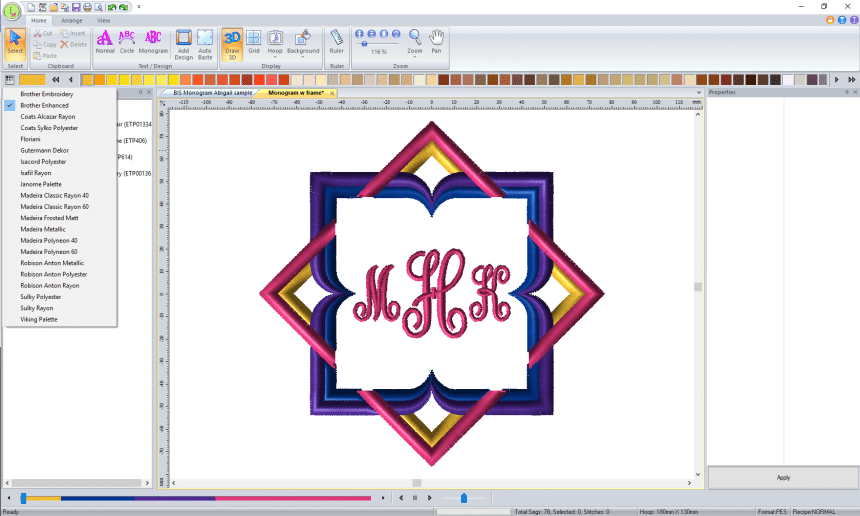
Let’s take a look at an example list of supported file types:
ART, DAT, UXX, C2S, GNC, CND, SEW, JEF, JEF+, MGL, STL, EXP, KSM, VP3, PCM, XXX, DST, DSB, DSZ, 10O, PCS, CSD, PES, VIP, SHV, HUS, TXT, PLT, DXF, QCC, CQP, HQF, SSD, IQP…
Granted, this is from the DIME Perfect Embroidery Professional, which is more of a commercial, pro piece of kit, not something a hobbyist would buy on a whim. All of the file types look incredibly confusing, but the output files are just those that different sewing and embroidery machines understand. Take a few for example, from Janome.com:
“.jef – The stitch-based file that is read by the MemoryCraft 10000.
.sew – The stitch-based file format used by MemoryCraft 5700, 8000, and 9000 machines.
.pes – A stitch-based file format used by Brother and Babylock embroidery home sewing machines.”
All you need to do is ensure that the embroidery software you are using and the embroidery machine you are using can both use the same file types and read and write those files, otherwise, they won’t be able to properly communicate with one another. It should be easy enough to check based on the machine setup you have.
Other file types include those for uploading images such as JPGs, some software will allow you to upload photos or scans and start to edit them as an embroidery pattern or applique.
What’s the difference? If something is good enough for commercial use, then it is good enough for home use, right?
Well, it is a bit more complex than that. Naturally, the price range changes a lot depending upon whether or not you are looking for embroidery software to use in your home as a bit of a hobby or if you need to embroider professionally and process garments or other embroidered items all day, every day.
The statement of something commercial being able to do as much, or more, than something that is good for home and hobbyist use, is definitely a truism. It is also kind of missing the point. Look at it this way; if you just want to do embroidery on the weekends or as something that you can have a bit of fun with, then you probably don’t want to spend hours and hours looking at tutorials or reading manuals. Something like the Amazing Designs LETTER IT! might be a good option, and while it is by no means the most powerful embroidery software out there, it is absolutely brilliant if you just want to install it on your computer and get started. You can quickly put together letter designs ready for embroidery. Cost is definitely one factor to think about when you are considering home use vs commercial use, but it is not the only factor. You don’t want to have software that is meant to be fun, quick and easy, that takes years to get the hang of.
The flip side of this, of course, is the fact that if you are using software commercially then you need to ensure that it is not limiting what you can offer. In a commercial environment you really need to pay attention to what is the industry-standard and how you can create the same designs as your competition. Naturally, it is a bit different depending upon whether you are monogramming, looking to create full exciting appliques or just doing some simple embroidery. The key is to match your needs to what the capabilities of the software you choose can offer.
This is also a vital feature. Some of the pieces of software on this list cost thousands of dollars. Imagine paying $5,000 for a piece of software and not getting help if it goes wrong or not having a way to contact anyone for more information about the software and problems you are having. Often, the bigger companies have very good customer service. This is due to them having a large infrastructure and staff that can handle people calling them.
Floriani Total Control U Embroidery Software is an example of a company with good customer service, too. They also have their own national education team to help people to get the most out of the software and run events where you can learn more about what is required to become a pro. This is to be expected with more expensive software.
Naturally, if you spend less, or buy something from Amazon, for instance, you aren’t likely to get as much customer service directly from those offering the software. On top of this, some of the software on the market is pretty outdated and may even be buggy on newer computer systems.
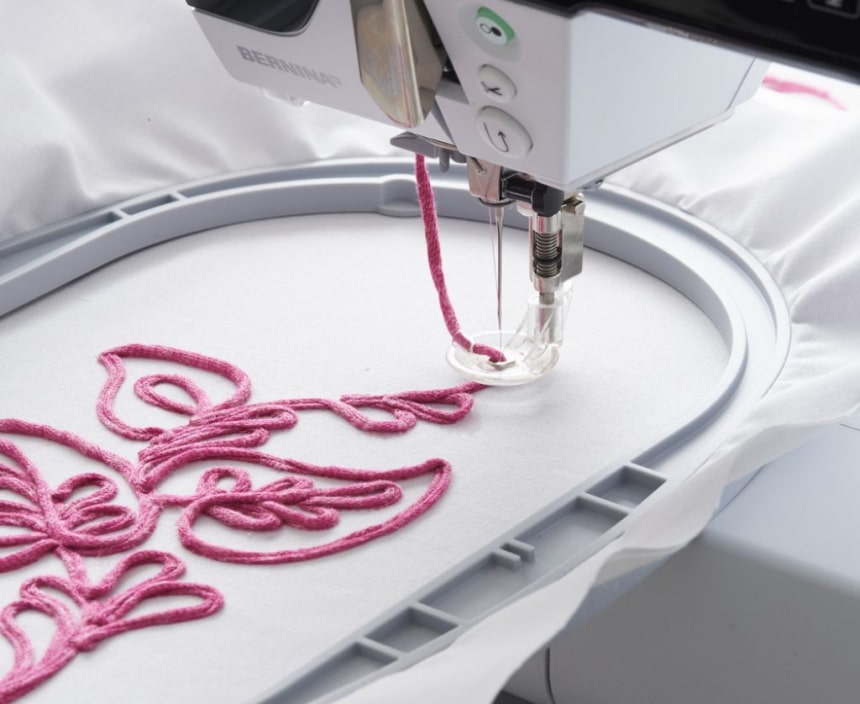
Other brands that many of us know and love, and associate with things like sewing and embroidery. Singer and Brother are two of the powerhouse brands, and they create their own versions of embroidery software. Sometimes, they sneakily encourage you to use their machines by limiting the compatibility with other devices, so watch out for this. Often, it is best to pair a Brother machine with Brother software, for example.
So, what should you be looking to pay for your embroidery software? How much is the average cost? It is incredible just how much variation you will find in the price of embroidery software. While there are models on the list that cost around $100-200, there are also models that are between $3,000 and $5,000. That’s a lot of money if you don’t know exactly what you are doing with embroidery or you are just looking to get started. The whole process of using an embroidery machine can start to get pretty pricey.
The software at the very top end of the market in terms of price is definitely made with professional use in mind. It can do way more than cheaper software models. This sort of software helps you to ensure that you are not getting left behind the competition. You wouldn’t turn up at an F1 race driving a 20 year old car that your grandma owned!
For people who are on a budget and for those just getting started, you can look at the free alternatives. There are a few out there, and though they come with their downsides they are worth exploring for hobbyists. A lot of people start with something that doesn’t have a cost or has a “freemium” version, and then eventually move on to more pricey software.
A lot of the time, the free software does eventually ask you to buy a license.
If your needs are a bit more simple and you just want something that is able to provide you with “converter” functionality and change your designs into something you can use with your embroidery machine, there are options like Tajima DGML by Pulse Ambassador, Designer Gallery and TrueSizer, which, as you probably expect, helps you to resize the designs.
When connecting to the computer, you should always check that the computer is actually compatible with the software first. You need to match these up at the time when you are making a purchase, so that you avoid the embarrassing issue of having to send the software back.
When transferring any design into your software you should make sure it is clean (nothing in the background if you have scanned it or taken a photograph) and you should also get as much quality in the image as possible.
When it comes to using the software effectively, ensure that you have taken some time to familiarize yourself. It is so easy to just dive in and start trying to make things. Some people learn brilliantly in this way, other people will find it an absolute nightmare to try and approach their embroidery like this. It is worth watching YouTube videos and getting a feel for the embroidery software first. You can watch some tutorials and read your manual to start to establish exactly what controls do what. All software is a little bit different in its own way, so it is important that you understand how to control yours, and at least get to grips with some of the basics before you start playing around with the machine.
Is it time for your first ever attempt at machine embroidery? We’ve got some tips on using both software and machines for the first time. You should make sure you spend a bit of time doing some research on this before you jump in and try to get things right with your embroidery. It is going to take a while, think of it a bit like learning to walk. Plus, whether it is for your job or for a hobby, using a machine for embroidery is fun! Enjoy the process of learning first.
Sometimes, when you buy a piece of software, you are entitled to a free license, or at least a discounted license, when a newer version of that software comes out. Once again this is manufacturer-specific, so you should look into this based on which piece of software you are thinking about moving forward with.
Some manufacturers create software in a way that doesn’t support other manufacturer’s file types to try and restrict them to using their own specific embroidery software. In general, though, most are pretty good. In our embroidery software reviews we have listed all of the file types that you can work with within that software, so you just need to check what files the machine can take before you go ahead and start buying and using software.
So, in theory, you can use any type of software with any machine, but make sure you plan ahead and check the compatibility of the files before you get started doing so.
The machine for commercial use will be $5,000 upwards new, and some bigger embroidery machines need to be custom installed and come with multiple heads for dealing with loads of garments at once.
It’s a valid question to try and work out how much the embroidery machine will cost you, because there is very little point getting super expensive software if you will only ever run it through an affordable machine that won’t be able to make the most of its potential. Similarly, if you are running a $10,000 embroidery machine in a factory, don’t think you are going to be able to get the most out of it if you just invest $50 in some software. You need professional software to keep up if you are using your embroidery machine in a commercial manner.
So, what is the verdict when it comes to choosing the best embroidery software? We’ve had to choose models to recommend, which isn’t easy, but here we go through our top picks. Our editor’s choice model is the Embrilliance Essentials, Embroidery Software for Mac & PC. It has great compatibility and is one of the few options you can actually use if you are running a Mac OS. We’ve given it a rating of 9.9 out of 10, and even though it is really powerful you can pick up the basics of using it really simply.
Taking the second spot on our list is the M & R Technologies pc Pro Cross Stitch Software, which has an affordable price but still offers high quality. This is best for you if you’re looking for flexibility and creativity, especially since it allows you to import different files and graphics. It’s also a good choice for those who want to make cross-stitch patterns.
Third on our list of the best embroidery software is the Brother Initial Stitch Embroidery Lettering & Monogramming Software. This is one of the best options if you are looking to make more complex designs but don’t want to spend a fortune. Some of the file types are a little restrictive, but generally this is both affordable and easy to pick up. We’ve rated it 9.8/10.
